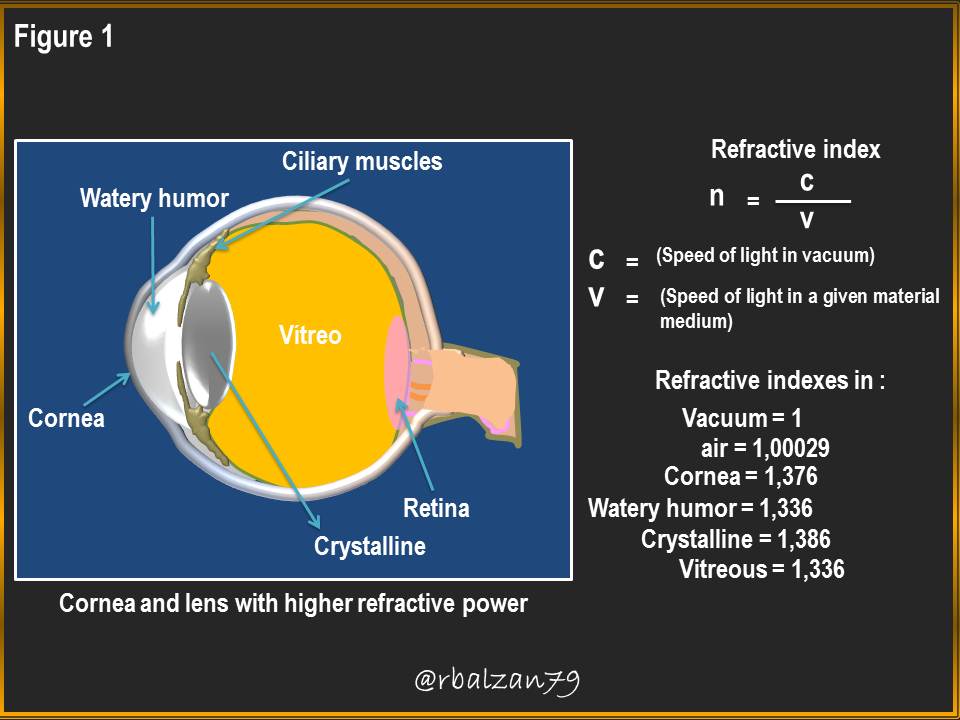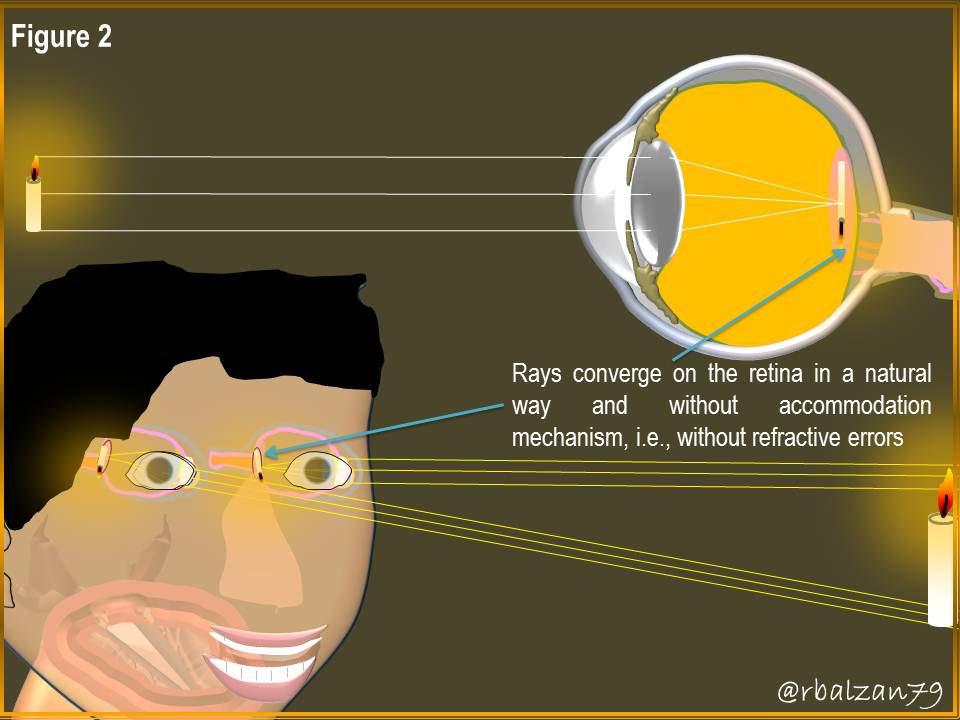
Introduction
When every person on this planet expresses how wonderful or beautiful everything around us is, they are undoubtedly making use of their natural optical instruments (eyes) to describe the above, but it is important to note that all this is possible thanks to the intervention of light rays in our ocular system, therefore, without light our eyes could not capture everything around us.
Let us remember that light rays are responsible for transporting each image we observe to our natural screen such as the retina, but, before performing such a vital process, these rays are refracted because they will find on their way different media through which they will have to pass, for example, to our natural lenses such as the cornea and the crystalline lens, a very important aspect that has aroused the great interest of the world of optical science.
In previous deliveries related to this type of content, we linked to the refractive power of some artificial lenses, and this, we did implementing the conceptualization of Diopter, therefore, this time we will use the Diopter in general to relate to the refractive power of our natural lenses, and this is because the diopter is nothing more than the representative unit of refractive power of the lenses either artificial or natural.
The intrinsic phenomenon of refraction of light rays plays a vital role in the generation of images on our retina, that is why it is important to relate to this aspect, for example, the closer the light rays concur in a single point will have higher quality images and this happens when they act on these rays refraction, and consequently the refractive power of the medium through which they pass.
With the optical aberrations analyzed in the past article we were able to know about some defocuses of the light rays refracted towards a certain screen, and also, how it was possible their correction by means of some artificial lenses both convergent and divergent, and this thanks to the analysis of the refractive power of the same ones.
As in artificial lenses, in our natural optical systems (eyes) also occur a series of defocusing in relation to the projection of light rays that go to our retina, for example, among some of these anomalies we have myopia, hyperopia and astigmatism, and these ametropias can be corrected with lenses, but this time we will begin by analyzing a normal or emmetropic eye, and in future installments we will relate to the ametropias indicated above.
Diopter of the human eye
When we relate to the human eye, we are undoubtedly relating to a complex optical system that allows us to perceive our environment through the generation of images, and for this, refraction is of great importance, therefore, my dear readers, let us remember that the phenomenon of refraction causes light to change its directionality because it passes through different media whose refractive power changes.
Therefore, in the first deliveries we could see how with the diopter we determine the refractive power of an artificial lens, but this is also possible to apply it to a natural lens, we also note that the higher the diopter value the higher the refractive power of the lens, and for the calculation of this value (Diopter) remember that it represents the inverse of the focal length expressed in meters, and the focal length is that measured from the center of a given optical system to the place called focal point.
As already mentioned, on this occasion we are going to relate to the refractive power of the natural lenses found in our natural optical systems (eyes), i.e., the cornea and the crystalline lens, all of this related to the treatment of light rays.
Our eyes represent a very complex optical system, where, there are different material media capable of refracting light before reaching our retina, therefore, it is important that in a general way we relate to the value of the refractive index of these elastic media that are inside our eyes, i.e. the aqueous humor, vitreous, cornea and lens.
For the above analysis, it is important to relate these refractive indices with those of vacuum and air, where we can notice how both the cornea and the crystalline lens are the optical elements of greater refractive power of light when it enters our eyes, for this purpose, let's observe the following figure 1.

In the previous figure 1, we can see in a general way the behavior of the luminous rays when they enter our eyes, and they go through different material or elastic media, and each one of them, with its particular refraction capacity, highlighting as it was expressed, both the refractive power of the cornea and of the crystalline lens.
Now it is important to relate our natural lenses with the diopter, and for this, we must say that the cornea represents the natural lens of greater refractive power of light rays, and therefore has a refractive power between +40 to +47 diopters, and this value will depend on the particular characteristics of the optical system of each person, As for the crystalline lens, its value oscillates between +20 diopters, where it is important to express that this optical element (crystalline lens) is very elastic which allows it to be accommodated by the small ciliary muscles and in this way increase its degree of curvature, that is why the crystalline lens can reach a refractive power of around 33 diopters.
An extremely important aspect to highlight is the fact that both the cornea and the crystalline lens have a convergent refractive behavior, that is, they manage to converge the luminous rays on our retina at the focal point, or as close as possible when they are in normal refractive conditions, and when this occurs there should not be any accommodation mechanism by our small ciliary muscles, this feature allows us to have a normal or emmetropic eye, as you can see below in Figure 2.

In the previous figure 2, they were able to visualize the normal functioning of our optical system, that is, an emmetropic eye, of course, it is of vital importance to highlight the congruence between the axial length of our eyes and the refractive power of both the cornea and the crystalline lens, because if some of the above aspects are not proportional to each other, we would be in the presence of different refractive defects or ametropias.
In relation to the above (ametropia) this would undoubtedly generate a problem in terms of the projection of images to the retina, as these images would be formed either in front or behind the retina, these ametropias will be talking in general terms in the following installments in order to continue expanding the knowledge related to light and its essential importance to our lives in terms of visual perception of our environment.
Conclusion
At every moment of our existence a great number of phenomena are developed around us, of course, each one with its particular characteristics, and also, some of them we can see and others not, when those that are possible to observe them is due to the action of the light rays since they transport these images to our eyes, of course we would be talking about that fraction of light that we call white or visible light.
Light represents our central phenomenon for the perception of our environment, but nevertheless, when it propagates and before reaching our eyes or particularly our retinas, it will encounter a large number of obstacles in its path and each of these will have its own particular characteristic to deflect these rays transporting images.
The above mentioned leads us to highlight the intrinsic importance of the phenomenon of refraction in the generation of images in the human eye, and with it, the importance of knowledge related to the refractive power of our natural lenses such as the cornea and the crystalline lens as you could see in this article.
In future installments we will continue to relate in a general way with the refractive power of our natural lenses expressed in diopters, and also with those ametropias due to poor focusing of images on our retina.
Until another time my dear readers of Hive, especially the members of the great #stemsocial community, for which I highly recommend being part of this beautiful project, because it highlights the excellent work of academia and the great work of the entire scientific field.
Note: All images were created using the Power Point application and the animated gif was created using the PhotoScape application.
Recommended Bibliographic References
[1]What’s a Diopter, and Why Do I Care Anyway?
Thanks for your contribution to the STEMsocial community. Feel free to join us on discord to get to know the rest of us!
Please consider supporting our funding proposal, approving our witness (@stem.witness) or delegating to the @stemsocial account (for some ROI).
Please consider using the STEMsocial app app and including @stemsocial as a beneficiary to get a stronger support.
Your content has been voted as a part of Encouragement program. Keep up the good work!
Use Ecency daily to boost your growth on platform!
Support Ecency
Vote for Proposal
Delegate HP and earn more
Informative write-up!
A clinical correlate
The idea of refraction or how convex the eye lens are go a long way in determining whether you're shortsighted or longsighted.
In which case, you are either prescribed a spectacle that has a concave lens to correct short-sightedness or a convex lens to correct long-sightedness.